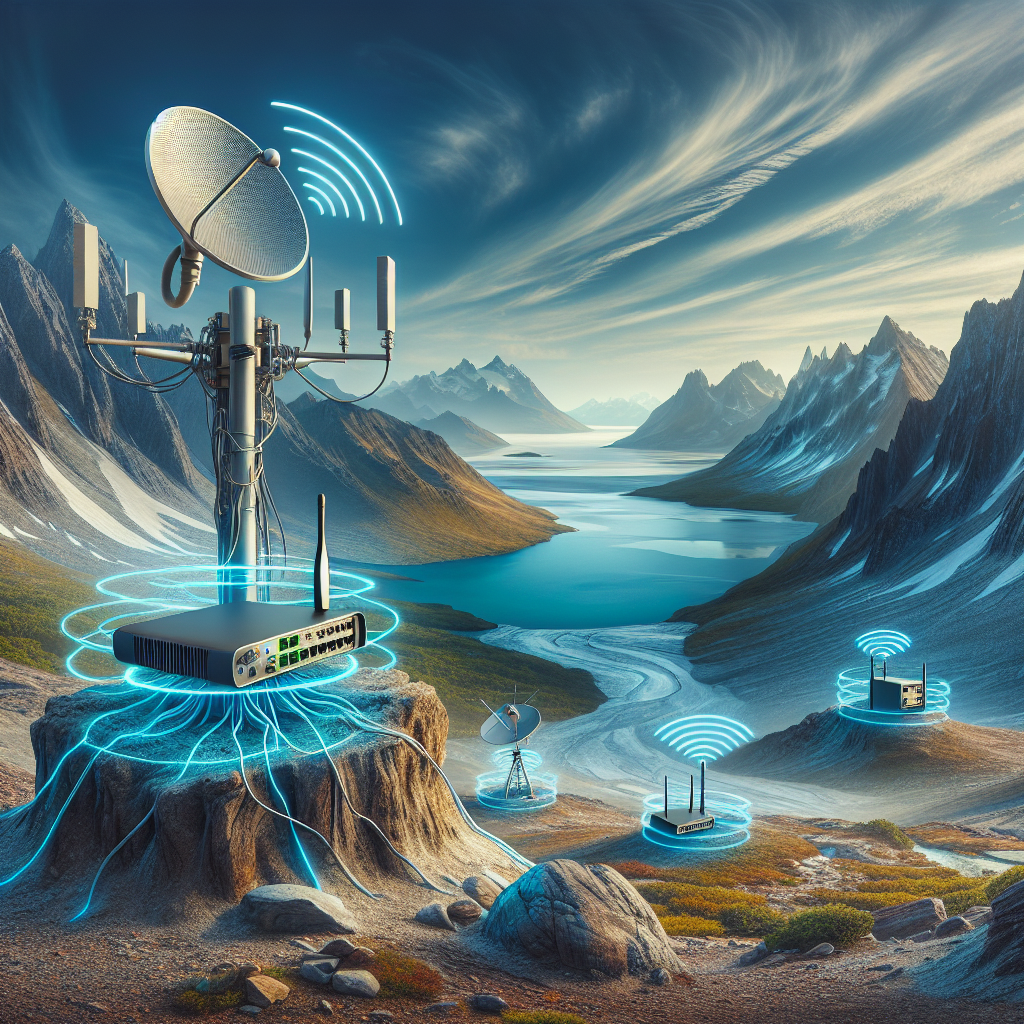In today’s increasingly connected world, the need for reliable and efficient communication in remote locations has never been greater. Wireless networking offers a solution that enables seamless connectivity in areas where traditional wired networks are impractical or costly. The wonders of wireless networking allow businesses, governments, and individuals to stay connected and productive even in the most isolated regions. This technology utilizes radio waves to transmit data, enabling users to access the internet, transfer files, and communicate with others from virtually anywhere. Join us as we delve into the limitless possibilities and benefits of wireless networking for remote locations.
Understanding Wireless Networking in Remote Locations

Wireless networking refers to the technology that allows devices to communicate and connect to the internet without the need for physical wired connections. In remote locations, where laying down traditional cables is often impractical or cost-prohibitive, wireless networking plays a crucial role in bridging the digital divide.
Definition of wireless networking
- Wireless networking utilizes radio waves to transmit data between devices, enabling communication over short or long distances.
- It involves the use of routers, access points, and antennas to create a network that enables devices to connect wirelessly.
Importance of wireless networking in remote areas
- In remote locations with limited infrastructure, wireless networking provides a cost-effective and efficient way to establish connectivity.
- It allows for the provision of essential services such as telemedicine, online education, and e-commerce in areas where traditional connectivity methods are challenging to implement.
- Wireless networking enables remote communities to stay connected to the global economy, access information, and communicate effectively, contributing to their socio-economic development.
Benefits of Wireless Networking for Remote Locations
Wireless networking in remote locations offers a myriad of benefits that cater specifically to the unique challenges faced in such environments. Here are some key advantages:
-
Increased Connectivity
- Wireless networking enables seamless connectivity even in areas where traditional wired connections are impractical or impossible to implement. This allows remote locations to stay connected to the internet, essential services, and other networks vital for operations.
-
Flexibility and Scalability
- Wireless networks offer a high degree of flexibility, allowing for easier expansion and adaptation to changing needs in remote locations. This scalability is particularly beneficial in environments where physical infrastructure changes may be difficult or costly to implement.
-
Cost-Effectiveness
- Implementing wireless networking in remote locations can often be more cost-effective than installing traditional wired networks. The reduced need for extensive cabling infrastructure and the ease of deployment contribute to lower upfront costs and long-term savings.
Factors to Consider for Wireless Networking in Remote Locations
When setting up wireless networking in remote locations, several crucial factors must be taken into account to ensure optimal connectivity and reliability. These factors play a significant role in determining the feasibility and success of wireless network deployment in challenging environments.
Wireless networking plays a crucial role in bridging the digital divide in remote locations by providing cost-effective connectivity solutions, enabling essential services, and contributing to socio-economic development. By overcoming challenges such as limited infrastructure, interference issues, and security concerns through strategic planning and best practices, wireless networking can unlock new opportunities for economic growth and social empowerment in remote communities.
Terrain and Topography
The terrain and topography of a remote location can significantly impact the performance of wireless networks. Mountainous regions, dense forests, or urban areas with tall buildings can obstruct signal transmission and lead to signal degradation or dead zones. Conducting a thorough site survey to analyze the landscape and identify potential obstacles is essential in designing an effective wireless network infrastructure. Employing signal boosters, strategically placing antennas, or utilizing mesh networking technology can help overcome terrain-related challenges and improve network coverage in remote locations.
Weather Conditions
Weather conditions pose another critical consideration for wireless networking in remote locations. Extreme weather events such as heavy rain, snow, or strong winds can affect signal strength and reliability. Harsh environmental factors like high humidity or temperature fluctuations can also impact the performance of networking equipment. Selecting weatherproof and ruggedized hardware, implementing redundant power supplies, and regularly monitoring network performance during adverse weather conditions are essential strategies to ensure uninterrupted connectivity in remote locations exposed to challenging weather patterns.
Power Source Availability
One of the fundamental requirements for establishing wireless networking in remote locations is access to a reliable power source. Off-grid or isolated areas may lack conventional power infrastructure, necessitating the use of alternative energy sources such as solar panels, wind turbines, or fuel generators to power networking equipment. Calculating power consumption, implementing energy-efficient devices, and deploying battery backup systems are vital considerations to maintain continuous network operations in locations where power availability is limited or unreliable.
Equipment Needed for Wireless Networking in Remote Locations
When setting up wireless networking in remote locations, several key pieces of equipment are essential to ensure reliable connectivity. These tools play a crucial role in establishing a robust network that can overcome the challenges of distance and terrain. Here are the primary equipment components required for successful wireless networking in remote locations:
-
Wireless Routers: Wireless routers serve as the central hub of a wireless network, enabling devices to connect and communicate with each other wirelessly. In remote locations, selecting a high-quality router with a strong signal range and advanced security features is vital to maintain a stable connection over long distances.
-
Antennas: Antennas are instrumental in extending the reach of a wireless network, especially in remote areas where geographical barriers may obstruct signals. High-gain antennas can amplify the signal strength and enhance coverage, making them indispensable for establishing connectivity in challenging terrains.
-
Repeaters: In remote locations where the distance between devices and the main router is substantial, repeaters are indispensable for extending the network’s range. These devices receive the existing wireless signal and rebroadcast it, effectively amplifying the coverage area and ensuring seamless connectivity even in far-flung areas.
By equipping your wireless network with these essential components, you can optimize connectivity in remote locations and unlock the full potential of wireless networking technology.

Challenges of Implementing Wireless Networking in Remote Areas
Limited Infrastructure
In remote locations, the lack of existing infrastructure poses a significant challenge for setting up wireless networks. The absence of reliable power sources and internet connectivity complicates the establishment of a robust network. Without adequate infrastructure such as towers for signal transmission or fiber optic cables for high-speed connections, deploying wireless networking solutions becomes a daunting task.
Furthermore, the scarcity of technical support and maintenance services in remote areas hinders the smooth operation of wireless networks. In the absence of readily available expertise to address issues like signal strength optimization or equipment malfunctions, maintaining network reliability becomes a persistent challenge.
Interference Issues
Wireless networking in remote locations often faces interference problems due to various environmental factors. The presence of natural obstacles like mountains, dense forests, or bodies of water can obstruct signal transmission and lead to connectivity issues. Additionally, competing radio frequencies from other wireless devices or nearby networks can cause interference, resulting in signal degradation and reduced network performance.
Moreover, weather conditions such as heavy rain, snow, or strong winds can further exacerbate interference problems in wireless communication. These environmental factors introduce unpredictability and instability into the network, making it challenging to maintain consistent and reliable connectivity in remote areas.
Security Concerns
Security is a critical challenge when implementing wireless networking in remote locations. The lack of physical security measures in isolated areas makes wireless networks vulnerable to unauthorized access and cyber threats. Without proper encryption protocols and authentication mechanisms, sensitive data transmitted over the network is at risk of interception and exploitation.
Moreover, remote locations often lack robust cybersecurity infrastructure and expertise to detect and mitigate potential security breaches effectively. This leaves wireless networks in these areas susceptible to attacks such as eavesdropping, data manipulation, or denial of service, compromising the confidentiality and integrity of communications.
Overcoming Challenges in Wireless Networking for Remote Locations
Implementing wireless networking in remote locations comes with its own set of challenges, from limited infrastructure to harsh environmental conditions. However, with advancements in technology and strategic planning, these obstacles can be effectively overcome. Here are some key strategies for tackling the challenges of wireless networking in remote areas:
-
Utilizing satellite technology: One effective way to overcome connectivity issues in remote locations is by leveraging satellite technology. Satellites can provide wide-reaching coverage, allowing for communication even in the most isolated areas where traditional network infrastructure is unavailable. By establishing a satellite link, remote locations can access the internet and stay connected with the rest of the world.
-
Implementing encryption protocols: Security is a significant concern when it comes to wireless networking, especially in remote locations where the risk of unauthorized access is higher. Implementing robust encryption protocols, such as WPA2 or VPNs, can help secure the wireless network and protect sensitive data from potential threats. By encrypting data transmissions, remote locations can ensure the confidentiality and integrity of their communication over the network.
-
Regular maintenance and monitoring: To ensure the reliability and performance of wireless networking in remote areas, regular maintenance and monitoring are essential. Remote locations often face challenges such as extreme weather conditions or power outages, which can disrupt network connectivity. By conducting routine maintenance checks and monitoring network performance, IT professionals can proactively identify and address any issues that may arise, ensuring uninterrupted connectivity for remote users.
Best Practices for Successful Wireless Networking in Remote Locations
Wireless networking in remote locations poses unique challenges that require careful planning and execution to ensure reliable connectivity. Implementing best practices can significantly enhance the performance and stability of wireless networks in such environments.
Conducting Site Surveys
Site surveys are crucial for assessing the terrain and environmental factors that can impact wireless signal strength and reliability.
By conducting thorough site surveys, network administrators can identify potential obstacles such as trees, buildings, or geographical features that may obstruct the wireless signal.
Furthermore, site surveys help determine the optimal locations for installing wireless access points to maximize coverage and minimize interference.
Establishing Clear Line of Sight
Clear line of sight is essential for maintaining strong wireless connections, especially in remote locations with challenging topography.
Ensuring there are no obstructions between wireless devices or access points is critical for achieving reliable communication over long distances.
By strategically positioning antennas and devices to establish clear line of sight, network administrators can mitigate signal degradation and interference, thus improving overall network performance.
Implementing Redundancy Measures
Redundancy measures are vital for minimizing network downtime and ensuring continuous connectivity in remote locations where access to technical support may be limited.
Implementing backup power sources, redundant hardware components, and failover mechanisms can help mitigate potential network disruptions caused by power outages, equipment failures, or environmental factors.
By proactively planning for contingencies and implementing redundancy measures, organizations can enhance the resilience of their wireless networks in remote locations, thereby improving overall reliability and uptime.
Case Studies of Successful Wireless Networking in Remote Locations
Example 1: Remote Village Connectivity Project
In a remote village located in the mountains of Nepal, a successful wireless networking project was implemented to provide internet connectivity to the residents. The challenging terrain and lack of infrastructure made it difficult to establish traditional wired connections. To overcome this obstacle, a team of experts set up a series of high-powered wireless routers strategically placed on mountain peaks to create a mesh network that covered the entire village. By using long-range directional antennas, the network was able to transmit signals over vast distances, providing the villagers with access to essential online services such as education resources, telemedicine, and e-commerce platforms. The project not only connected the village to the digital world but also empowered the community by opening up new opportunities for economic growth and social development.
Example 2: Communication Setup for Disaster Relief Efforts

During a natural disaster in a remote coastal region, traditional communication infrastructure was severely damaged, leaving the affected population isolated and in need of urgent assistance. In response, a rapid deployment team utilized wireless networking technology to establish a temporary communication network that enabled coordination among emergency responders, government agencies, and affected communities. By leveraging satellite connections and portable wireless routers, the team was able to quickly restore vital communication links, allowing for real-time information sharing, resource allocation, and rescue operations. The wireless network proved to be crucial in facilitating effective disaster relief efforts, demonstrating the resilience and flexibility of wireless technology in remote and challenging environments.
Future of Wireless Networking in Remote Locations
The future of wireless networking in remote locations is poised for significant advancements, driven by ongoing technological innovations that continue to push the boundaries of connectivity. These advancements are not only enhancing the capabilities of wireless networks but also expanding their reach to the farthest corners of the globe.
- Advancements in Technology
Wireless networking technologies are evolving at a rapid pace, with the development of 5G networks promising unprecedented speed and reliability even in the most remote locations. The implementation of technologies such as beamforming and mesh networking is revolutionizing the way data is transmitted, ensuring more efficient and robust connectivity in areas previously deemed inaccessible.
- Integration with Internet of Things (IoT)
The integration of wireless networking with the Internet of Things (IoT) is opening up a world of possibilities for remote locations. By enabling seamless communication between devices and sensors, wireless networks are facilitating the collection and analysis of real-time data, leading to improved efficiency, productivity, and decision-making in various sectors such as agriculture, healthcare, and environmental monitoring.
- Potential Impact on Remote Communities
The potential impact of wireless networking on remote communities is profound, offering newfound opportunities for economic development, education, and healthcare. By bridging the digital divide and providing access to online resources and services, wireless networks have the power to empower individuals and communities, fostering innovation and growth in even the most isolated regions.
FAQs: Exploring the Wonders of Wireless Networking for Remote Locations
What are some benefits of using wireless networking for remote locations?
Wireless networking offers several advantages for remote locations. One of the main benefits is the ability to easily connect multiple devices without the need for physical cables. This can save time and resources when setting up a network in hard-to-reach areas. Additionally, wireless networking allows for greater flexibility and scalability, making it easy to expand the network as needed.
What factors should be considered when setting up wireless networking in a remote location?
When setting up wireless networking in a remote location, there are several factors that should be taken into consideration. One important factor is the terrain and environment of the area, as this can impact the signal strength and range of the wireless network. Other factors to consider include the power source available, potential interference from other wireless devices, and the security measures that need to be implemented to protect the network.
How can I ensure a reliable connection for wireless networking in remote locations?
To ensure a reliable connection for wireless networking in remote locations, it is important to conduct a site survey to determine the best locations for access points and antennas. Properly positioning equipment and using quality hardware can help improve signal strength and reduce the chances of network downtime. Additionally, implementing security measures such as encryption and strong passwords can help protect the network from unauthorized access. Regular maintenance and monitoring of the network can also help identify and address any potential issues before they escalate.
Are there any limitations to using wireless networking in remote locations?
While wireless networking offers many benefits for remote locations, there are some limitations to consider. One limitation is the potential for interference from other electronic devices or physical obstacles that can disrupt the signal. Additionally, the range of wireless networks can be limited, especially in areas with challenging terrain or environmental conditions. It is important to carefully plan and design the network to mitigate these limitations and ensure reliable connectivity.